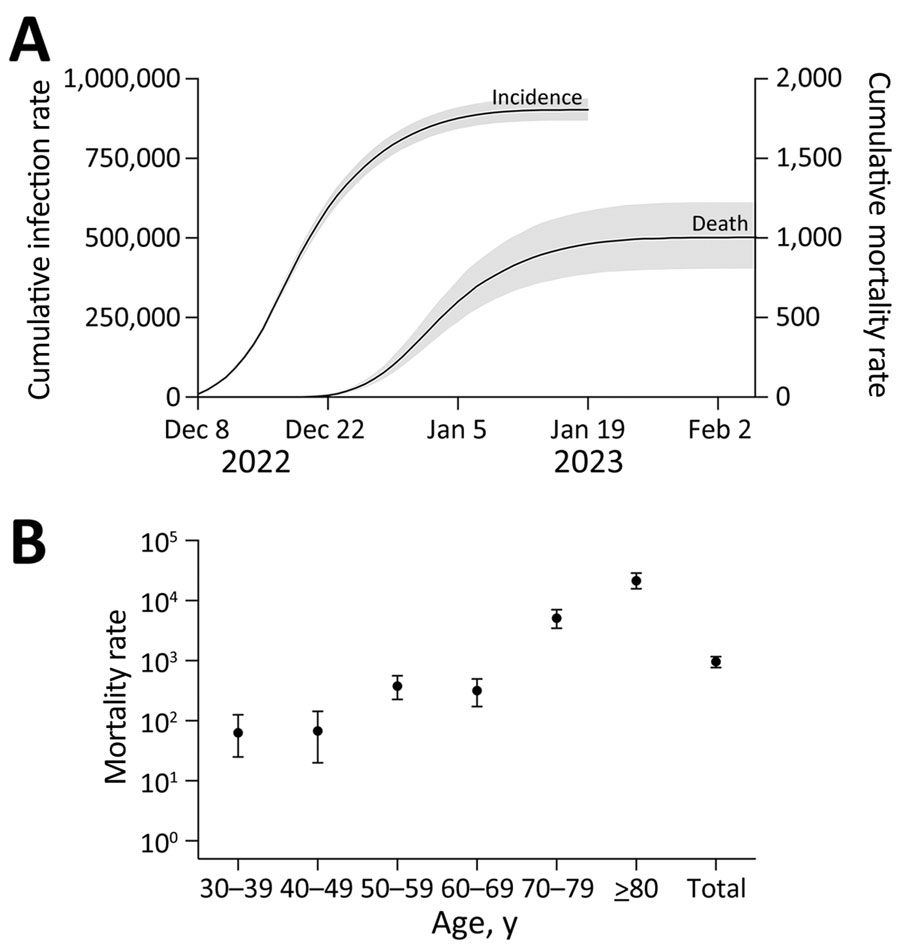Volume 29, Number 10—October 2023
Dispatch
Estimate of COVID-19 Deaths, China, December 2022–February 2023
Figure

Figure. Estimated SARS-CoV-2 infection incidence in China during December 16, 2022–January 19, 2023, and resulting COVID-19 mortality rates. A) Estimated cumulative infection and mortality rates (per 1 million population) during December 8, 2022–February 7, 2023, based on test positivity data from the Chinese Center for Disease Control and Prevention sentinel community surveillance system, reported on January 26, 2023 (5). Gray shading indicates 95% credibility intervals derived from 1,000 stochastic simulations. B) Estimated age-specific COVID-19 mortality rates (deaths/1 million population, log scale), based on simulations that incorporate vaccine timing, coverage, effectiveness, and waning in each age group.
References
- Mathieu E, Ritchie H, Rodés-Guirao L, Appel C, Giattino C, Hasell J, et al. Coronavirus pandemic (COVID-19). Our World in Data. 2020 Mar 5 [cited 2023 Feb 4]. https://ourworldindata.org/covid-cases
- China CDC. National epidemic situation of COVID-19 disease (2023–01–15). 2023 [cited 2023 Feb 14]. https://www.chinacdc.cn/jkzt/crb/zl/szkb_11803/jszl_13141/202301/t20230115_263381.html
- National Health Commission. Transcript of press conference of the State Council’s joint prevention and control mechanism for the novel coronavirus pneumonia outbreak (December 20, 2022). 2023 [cited 2023 Feb 1]. http://www.nhc.gov.cn/xcs/s3574/202212/a9510969ad85461297016f6ad1c87770.shtml
- Lewis D. China’s COVID wave has probably peaked, model suggests. Nature. 2023;613:424–5. DOIPubMedGoogle Scholar
- Chinese Center for Disease Control and Prevention. COVID-19 clinical and surveillance data—Dec 9, 2022 to Jan 23, 2023, China. 2023 Jan 26 [cited 2023 Jan 28]. https://en.chinacdc.cn/news/latest/202301/t20230126_263523.html
- Nyberg T, Ferguson NM, Nash SG, Webster HH, Flaxman S, Andrews N, et al.; COVID-19 Genomics UK (COG-UK) consortium. Comparative analysis of the risks of hospitalisation and death associated with SARS-CoV-2 omicron (B.1.1.529) and delta (B.1.617.2) variants in England: a cohort study. Lancet. 2022;399:1303–12. DOIPubMedGoogle Scholar
- Cai J, Deng X, Yang J, Sun K, Liu H, Chen Z, et al. Modeling transmission of SARS-CoV-2 Omicron in China. Nat Med. 2022;28:1468–75. DOIPubMedGoogle Scholar
- Gundlapalli AV, Lavery AM, Boehmer TK, Beach MJ, Walke HT, Sutton PD, et al. Death certificate–based ICD-10 diagnosis codes for COVID-19 mortality surveillance—United States, January–December 2020. MMWR Morb Mortal Wkly Rep. 2021;70:523–7. DOIPubMedGoogle Scholar
- Liu J, Zhang L, Yan Y, Zhou Y, Yin P, Qi J, et al. Excess mortality in Wuhan city and other parts of China during the three months of the covid-19 outbreak: findings from nationwide mortality registries. BMJ. 2021;372:n415. DOIPubMedGoogle Scholar
- Smith DJ, Hakim AJ, Leung GM, Xu W, Schluter WW, Novak RT, et al. COVID-19 Mortality and Vaccine Coverage - Hong Kong Special Administrative Region, China, January 6, 2022-March 21, 2022. MMWR Morb Mortal Wkly Rep. 2022;71:545–8. DOIPubMedGoogle Scholar
- Wang H, Paulson KR, Pease SA, Watson S, Comfort H, Zheng P, et al.; COVID-19 Excess Mortality Collaborators. Estimating excess mortality due to the COVID-19 pandemic: a systematic analysis of COVID-19-related mortality, 2020-21. Lancet. 2022;399:1513–36. DOIPubMedGoogle Scholar
- Wong JY, Cheung JK, Lin Y, Bond HS, Lau EHY, Ip DKM, et al. Intrinsic and effective severity of COVID-19 cases infected with the ancestral strain and Omicron BA.2 variant in Hong Kong. J Infect Dis. 2023;•••:
jiad236 ; Epub ahead of print. DOIPubMedGoogle Scholar - Hale T, Angrist N, Goldszmidt R, Kira B, Petherick A, Phillips T, et al. A global panel database of pandemic policies (Oxford COVID-19 Government Response Tracker). Nat Hum Behav. 2021;5:529–38. DOIPubMedGoogle Scholar
- Wang X, Du Z, Huang G, Pasco RF, Fox SJ, Galvani AP, et al. Effects of cocooning on coronavirus disease rates after relaxing social distancing. Emerg Infect Dis. 2020;26:3066–8. DOIPubMedGoogle Scholar
- Wang X, Du Z, Johnson KE, Pasco RF, Fox SJ, Lachmann M, et al. Effects of COVID-19 vaccination timing and risk prioritization on mortality rates, United States. Emerg Infect Dis. 2021;27:1976–9. DOIPubMedGoogle Scholar
Page created: August 08, 2023
Page updated: September 20, 2023
Page reviewed: September 20, 2023
The conclusions, findings, and opinions expressed by authors contributing to this journal do not necessarily reflect the official position of the U.S. Department of Health and Human Services, the Public Health Service, the Centers for Disease Control and Prevention, or the authors' affiliated institutions. Use of trade names is for identification only and does not imply endorsement by any of the groups named above.